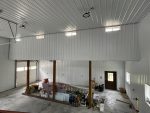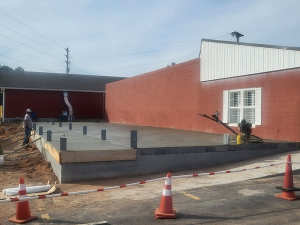Proper Screw Location for Post Frame Steel Cladding
It was a pleasant October evening back in 1985 in Blacksburg, Virginia. My friend Dr. Frank Woeste was then a College of Agricultural and Life Sciences professor at Virginia Tech (officially Virginia Polytechnic Institute and State University) and he had invited me to teach one of his classes for a day, in exchange for him providing some basic engineering software to design post frame building columns, roof purlins and wall girts.
Back in 1985, Virginia Tech had not yet become a NCAA football powerhouse it grew into under the direction of Hokies’ head coach Frank Beamer – having participated in post season bowl games for 23 consecutive seasons starting in 1993. This also long predated an April 16, 2007 tragedy when Virginia Tech student Seung-Hui Cho fatally shot 32 faculty members and students, wounding 17 others before killing himself on campus. This shooting remains as the third deadliest mass shooting committed by a lone gunman in United States history.
Mid-way through an evening with Frank, after digesting a hearty meal and debating whether hops in our consumed liquids were a fruit or a vegetable (they actually are neither – they are flower cones), we digressed into Dr. Woeste’s research’s true essence at Virginia Tech – post frame buildings and prefabricated metal connector plated wood trusses.
Narrowing things down, a lively discussion occurred (including some of his grad students) on whether steel roofing and siding for post frame buildings should be attached with screws through ‘flats’ or on high rib tops.
You may be wondering what brought this particular subject to mind after so many years? In case you happened to, my Facebook friend Trenton had asked me this very question recently.
For years steel roofing and siding had been attached with ring shanked nails (read more about this and Dr. Woeste here:
( https://www.hansenpolebuildings.com/2011/12/ring-shank-nails/). Traditionally nails were located upon high rib crowns – knowing not all nails would be identically driven through steel into underlying wood. The belief was that rain running off a roof would never get high enough to leak around improperly seated nails on high rib tops!
So, what would happen if screws were improperly placed in those steel high rib tops?
Properly designed post frame buildings are dependent upon diaphragm action provided by the steel skin (roofing and siding). Numerous tests have been done to confirm shear strength of panels as properly fastened. When screws are placed through high ribs, there is a 5/8 to ¾ inch gap between high rib underside and framing below. Screw shanks can flex within this space, reducing shear load carrying capacity of this sheathing system.
Furthermore, screw flexation in this gap, allows steel panels to move slightly under wind or seismic loads, eventually contributing to slots being formed in steel around screw shanks, and over time, causing leaks.
Ultimately Frank and I agreed with every steel roofing and siding roll former – screws in flats, not on ribs!










What about stitch screws on laps in addition to the fasteners on flats?
Unless they are needed due to very high shear loads, there is no reason to use stitch screws on typical post frame building panels.